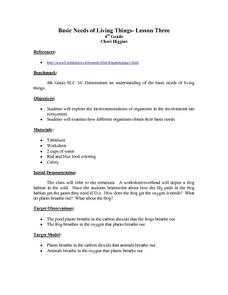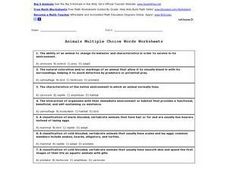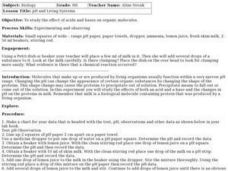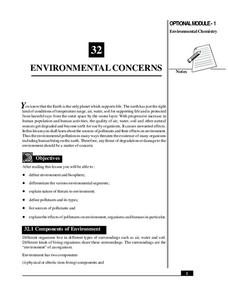Curated OER
Investigating the Behavior of Lumbriculus
Students perform a classroom experiment on the organisms of worms. They view the behaviors of the worms and analyze their results. This lesson introduces students to the techniques involved in behavioral studies.
Curated OER
Following Digestion of a Meal
In this digestion worksheet, students review the organs involved in the digestive process along with the function of these organs. This worksheet has 5 fill in the blank, 8 short answer, and 7 matching questions.
Curated OER
Recyclers to the Rescue
Fifth graders examine the concept of the food chain and define producer, consumer, herbivore, carnivore, and omnivore. They draw a food chain for a mouse and discuss the different organisms involved in the chain, and conduct an...
Curated OER
Protection, Support, and Locomotion
In this skeletal system worksheet, students will read a graphic organizer and complete 1 short answer question about the five functions of the skeleton. Then students will use a graphic organizer about muscle types to fill in a table...
Curated OER
Digestion and Nutrition
In this digestion worksheet, students will match 12 terms associated with the digestive system to their correct definition. The vocabulary words review the digestive system organs and their functions.
Curated OER
Basic Needs of Living Things-Lesson Three
Fourth graders explore the interconnectedness of organisms in the environment and examine how different organisms obtain their basic needs. They discuss a frog's habitat and what is found in it. Students discuss the processes of...
Curated OER
Classification and Binomial Nomenclature
Students practice identifying different groups of living organisms using a dichotomous key. Students also examine the history of an organism and its lineage by writing a paragraph about it and "three generations" of ancestors.
Curated OER
Exploring Learned and Innate Behavior
Compare and contrast learned and innate behaviors between humans and primates. Your biology class members read articles and participate in discussions about the use of tools and communication methods. That's about it, you'll probably...
Curated OER
Animals Multiple Choice Words Worksheet
Looking for some simple multiple-choice questions for an upcoming biology unit on animals? This worksheet features 7 clearly worded questions, each with 4 possible answers. Topics include adaptation, camouflage, ecosystems, animal...
Curated OER
Patterns of Heredity Vocabulary
Test your students' biology vocabulary skills with this review sheet, in which students define twelve different vocabulary terms related to patterns of heredity. Using the word bank provided, 9th graders complete eight sentences with the...
Curated OER
Organizing Life
In this classification worksheet, students will review vocabulary words associated with the organization of living things which includes kingdom, phylum, class, order, family, genus, and species. This worksheet has 5 fill in the blank...
Curated OER
Development Before Birth
In this development worksheet, high schoolers review the process of fertilization in placental organisms. Students determine what trimester certain events take place in a fetus' development. This worksheet has 10 fill in the blank and 7...
Curated OER
Mollusks and Segmented Worms
In this mollusks and segmented worms activity, students read information about these two groups of organisms and compare and contrast their general characteristics. This activity has 2 short answer questions.
Curated OER
Blood and the Circulatory System
In this circulatory system worksheet, students review the organs that are involved with this body system, including their structure and function. Students explore the problems that can occur with the circulatory system. This worksheet...
Curated OER
Effects of pH on Organic Molecules
Students investigate the effects of an acid and a base on the structure of milk protein. They observe the changes to droplets of milk when adding ammonia and lemon juice and relate the changes to old, curdled milk. An extension using...
Curated OER
Leaving Home
Students explain the importance of larval dispersal and retention to populations. They collect data on organisms and examine it.
Curated OER
Life at the Pond
Students identify the bugs collected from the pond. In this biology lesson, students observe the living and nonliving organisms in the pond environment. They write a reflection about why nature is important and must be preserved.
Curated OER
Internal vs. External Fertilization
Students distinguish between internal and external fertilization. In this biology lesson, students classify organisms according to their reproductive method. They simulate the role of parents who reproduce either internally or...
Curated OER
Bean Bugs
Students practice how to estimate the size of a population of organisms. In this estimation lesson, students hypothesize how to estimate a population of organisms. Students learn to use a quadrat system to estimate population.
Curated OER
Ecosystem Relationships
Students study the relationship between the types of trees, soil, and organisms. They investigate the complex interactions and cycles at work in the forest and understand the factors that contribute to a healthy, sustainable forest.
Curated OER
Structures Of Life
Learners investigate the basic conceptual structures of plants, with the focus being the parts that contain seeds. They comprehend that organisms that have fruit for the holding of seeds for replication of the species. The students work...
Curated OER
Probability
Here is a classic activity used to introduce your class to the concept of probability and data collection. They will roll one die 30 times, then record and discuss the results. Great introduction, but too shallow to be considered a...
Biology Junction
Arthropods
Even the creepy crawlers have pretty amazing anatomy! A thorough lesson describes characteristics of arthropods with an emphasis on their structures. Beginning with a review of the taxonomy hierarchy, the lesson explains the different...
National Institute of Open Schooling
Environmental Concerns
Every year, more than 14 billion pounds of garbage is dumped into the oceans of the world, most of which is plastic and toxic to ocean life. Lesson 32 in the series of 36 focuses on environmental concerns, specifically pollution. Under...























